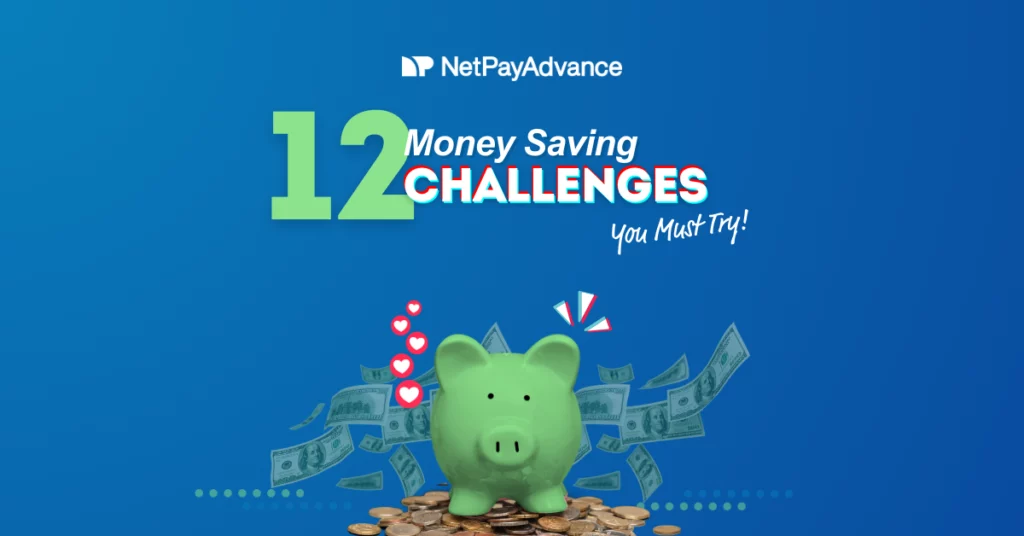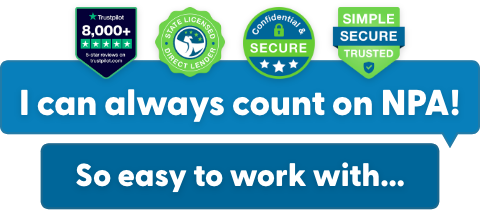Ready to make things interesting? We’ve got some ideas!
Kick-start your journey towards growing savings by taking on a few challenges. After all, challenges are a part of life and sometimes, they are important for growth. These money saving challenges will keep you on track as you attempt to curb spending and work towards your financial goals. Test your financial discipline by trying one of these money savings challenges. These money savings challenges are tried and tested by our own team. Read on to see their experiences.
Are you an over spender? Do you often go over budget? Well, you aren’t alone. 83% of Americans claim to overspend and most of them use credit cards to do so. Even some of our own teammates are guilty of this. Hey, we’re all human. With the economy being what it is and inflation taking a steep surge, it is important for most people to monitor their spending habits and put money aside for a rainy day.
Even if you have a steady income, you never know when that changes. In 2023, layoffs hit a high of 98% and it is predicted to get worse. Knowing this, being realistic and getting prepared seems like the smart thing to do. Will you be able to stay afloat in case something impacts your current income, or you face an unexpected expense? This is where saving money pays off.
The average American has $1200 in savings. Although that isn’t nothing, it is not a significant amount either. Especially if you have dependents. Saving money can save you from not being able to afford necessities.
Explore our list of money saving challenges and you can thank us later.
12 money saving challenges


Let’s make saving money fun with these money saving challenges:
1. See how many services you can unsubscribe from to help with savings
The average American spends an estimated $219 on subscription services every month. Challenge yourself to reevaluate your subscriptions and unsubscribe a few. Do you really need to be paying for five different streaming services? Who knows, maybe you will resort to other productive hobbies like reading or gardening when you don’t have two hundred shows to watch.
I asked some of my teammates about cancelling subscriptions and they each had something interesting to say. Renee McBride shares, “I gladly cut the cord on cable in 2019 and haven’t looked back. My $20 monthly savings adds up at the end of the year to $240.”
Be conscious of what you cut. Make sure it’s something unneeded. For example, I would never suggest cancelling a gym membership unless one can procure cheap equipment, has space in their home to work out, and has the discipline to stay on-track with their goals.
Take a look at some of the tidbits my other teammates have shared:

More quotes from my teammates:
“I canceled my Freshly subscription after about 6 months because one, it was WAY too much food and two, the options for the meals were limited. I felt like I was stuck with eating the same thing week in and week out.” – Emily Johnson
“I have unsubscribed from Game Pass that is offered through Xbox. So many of their games were hit or miss. I’d rather pay for the few games I know I will enjoy and complete all the way through.” – Jeremy Cavender
“I unsubscribe from Paramount+ outside of football season and feel good knowing I’m not spending money on something I’m not using more often.” – Morgan Lyles
2. The 100-day challenge
The premise of this challenge is that you set aside $1 on the first day, $2 on the second, and go all the way to $100 on the hundredth day. Your total adds up to $5,050, which is a very impressive amount to have saved up in a hundred days.
However, not everyone might be able to put aside higher values each day towards the end. That’s what our teammate experienced when they tried this money savings challenge. Therefore, I recommend doing this challenge with a twist – save what you can every day. Even if you put aside four dollars every single day, you still end up with $400 at the end of your hundred days.
This challenge could help break habits like getting an overpriced coffee daily if you are motivated to do so and you save $7 every day. That adds up to $700 in a hundred days and $2,555 a year if you do it long-term.
3. Make it a weekly affair with a weekly savings challenge
If the 100-day challenge isn’t for you, how about a slightly different version? Set aside $100 every week and at the end of the year, you have $5,200. If $100 a week is not feasible, you can set a lower amount and complete the challenge.
Alternatively, you could set aside money from each paycheck. If you get paid bi-weekly, you receive 26 paychecks in a year. Setting aside $100 from every paycheck will add up to $2,600.
To make things easier, set up an automation to transfer funds to a savings account on the same day your paycheck hits your bank account. “A ‘“set it and forget it’” is what you’re going for here,” Ariel shares.
4. No-spend November or any other month
If you’re anything like me, you have items in your Amazon cart that you don’t necessarily need. Pick a month and commit to not spending on wants and only spending on needs. Before making a purchase, assess if you need that item in the next week or so, and only then proceed to pay.
If you need it later, wait until next month to purchase it. More than likely, you’ll forget about it and realize you didn’t need it in the first place. It is always a smart idea to have a realistic budget in place. If you don’t have one right now, consult our resource on getting started with a budget. For added convenience, use a budgeting app to help manage your money effectively.
To make no-spend month effective, avoid places and situations that usually require spending money. Our own teammate Emily Johnson tried no-spend January. You can see how she did throughout the month on TikTok.

5. The 30-day home cooking challenge
Don’t worry, you don’t have to be exceptionally skilled to pull this off. There are plenty of beginners’ recipes available online. You could even ask friends and family to share their favorite recipes.

So, make lists of ingredients you need and remember to check out our blog on saving money on groceries. It’s just 30 days. You can do this!
6. The positive side of peer pressure – a friendly savings competition amongst friends
Sometimes peer pressure can be a good thing. Hear me out. If you get a friend or a couple of friends interested in money saving challenges with you, you can keep each other accountable and tally your savings at the end of the period to see who did the best. That’s what our team did while trying some of these money savings challenges.
People with different income levels and cost of living will have different amounts in savings but you can always compare how much each of you saved as a percentage of your income to keep things equitable.
7. Brand switching for more savings
We get it, we’re all partial to certain brands when it comes to things we enjoy. Some have a preferred brand of ketchup while others are particular about their laundry detergent. Do some research to identify cheaper alternatives from other brands. You could even make a comparative analysis of stores that offer better prices and shop accordingly.

Switching to a different brand might spark anxiety in some people. Perhaps reading online reviews beforehand would help.
8. Substitute retail therapy with something else
Marketing strategies and social media influence have vastly contributed to our need to impulse buy. 73% of Americans have admitted to making most purchases impulsively. That is three out of four Americans! Some of us are guilty of emotional spending. The desire to shop compulsively often stems from deep-rooted emotions such as boredom, sadness, loneliness, or pure euphoria.

Retail therapy as many call it, is not a solution to manage one’s emotional triggers. We recommend channelizing your energy towards other activities like volunteering at your favorite non-profit or anything similar that might bring you joy. Our team shares some other hobbies they’ve found to replace retail therapy with:
- Reading
- Playing video games
- Painting
- Working out
- Going on drives
- Crafting gifts
9. Only if it’s free! Challenge yourself to only do free things for a bit
Set a month or a fortnight to only do things that don’t cost anything. Instead of concerts and events with an entry fee, look up community events that are free to the public. If you’re based in California, we have a list of free things to do. Based in Texas? We have a free things to do list for you as well.
If you are a parent, you can replace paid activities like mommy-and-me classes or pottery painting with trips to your local library which are free of cost. Public libraries have several events for kids, and you should check out their website for details.
A picnic in the community park or a movie night at home are other fun things to do that don’t cost anything extra.
10. Test how far you can stretch a dollar
Don’t we all want to make our paycheck last longer? One way to do so is to try and stretch every dollar. This can be done by mindful spending and utilizing items you already have before buying more. For example, challenge yourself to spend only a set amount for gas and try to stick to it by resorting to carpooling, walking, or biking to places if possible. Agree to lower your energy bill by being conscious of wastage and turning off appliances when not in use. When you go out to dinner, pick meals that can be split and shared between you and a date. Small things add up.
11. A match program for guilty purchases
Not everyone has the most self-control when it comes to avoiding purchases. However, Renee McBride knows a person that every time they make what they consider to be a “dumb purchase,” (their words, not ours!) They take the same amount of money out of their checking account and move it to a savings account. For example, if they purchase a $20 video game, they move over $20 to their savings.

12. The tracking challenge

Some of us track our steps and our sleep quality, why not extend the same to our expenses? Make it a habit to track all your expenses so that you can see where your money goes. There are plenty of apps that allow you to track your expenses. Try to spend less this month. Then do it again next month. Compare results month-by-month and see if you can beat your own scores all-time-low score!
If you don’t want to download another app, you can make a sign for your home, and treat it like a church fundraising thermometer, or like a high score of a video game. Either way, as you save more money, you’ll track it visually.
Do we hear a cha-ching?
Money is a primal need. We all want a decent life and even without the frills and fancies, the cost of living has significantly increased in recent times. That’s why plenty of people start a side hustle for a second source of income. Some people may change jobs while others switch careers and find better paying jobs that don’t require a college degree. Regardless of what you choose, there is no denying that building your savings can be a lifesaver.
We encourage our readers to gain a better understanding of their finances. At Net Pay Advance, we deliver payday loans online with a commitment to education. Our team maintains a finance blog where we explore various topics related to money. We wish you the best as you embark on your savings success story and hope these challenges are just the push you need. Always remember, we’re just one click away if you ever need some financial help.


